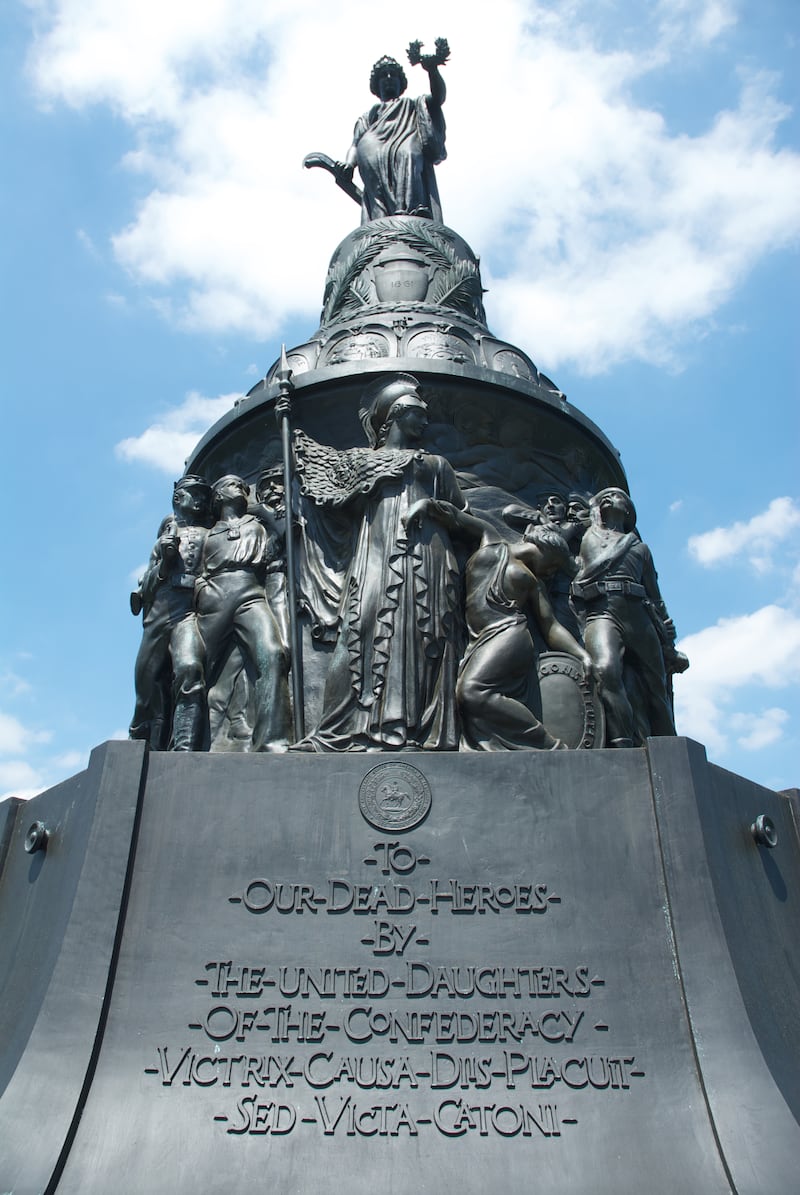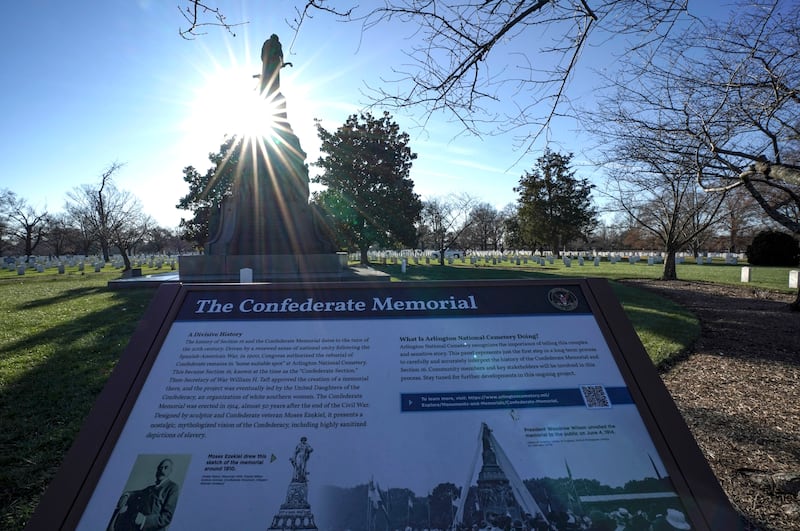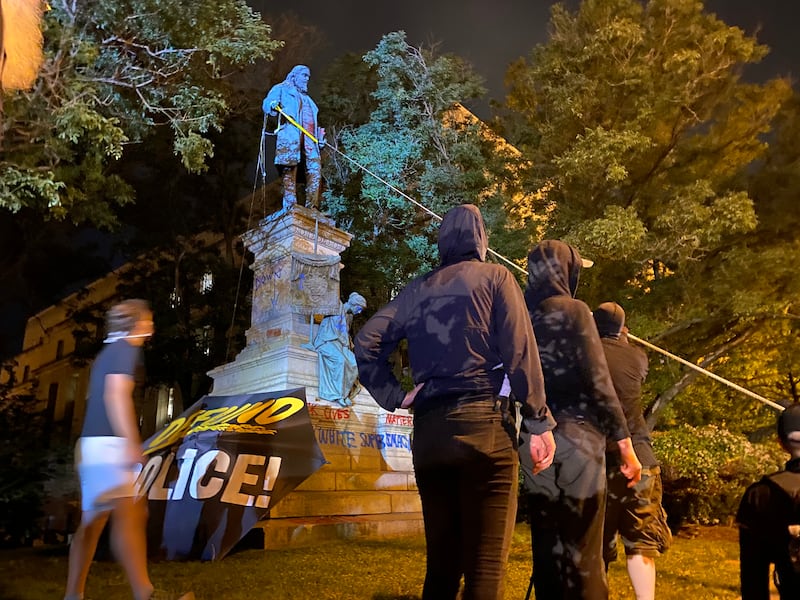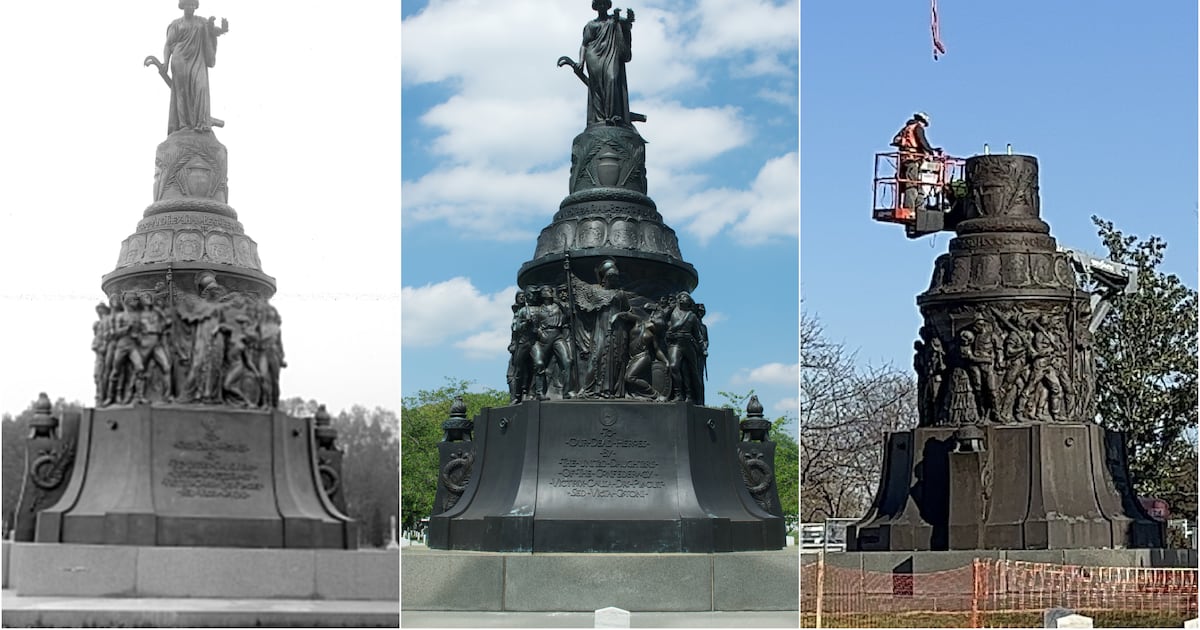Defense Secretary Pete Hegseth announced that Arlington National Cemetery will be restoring a Confederate monument criticized for misrepresenting the history of slavery.
As part of President Donald Trump’s efforts to reintroduce Confederate symbols and monuments, Moses Ezekiel’s “beautiful and historic sculpture,” the Confederate Memorial, “will be rightfully be returned to Arlington National Cemetery near his burial site,” Hegseth said in a social media post.
“It never should have been taken down by woke lemmings. Unlike the Left, we don’t believe in erasing American history—we honor it,” Hegseth said.
Ezekiel was a Confederate soldier who spent much of his artistic career promoting the “Lost Cause” myth that the Civil War was just and heroic, and not a treasonous war fought to uphold slavery.
 Defense Secretary Pete Hegseth claimed the memorial, which has long been criticized for its depiction of slavery, was removed by “woke lemings.” SAUL LOEB/AFP via Getty Images
Defense Secretary Pete Hegseth claimed the memorial, which has long been criticized for its depiction of slavery, was removed by “woke lemings.” SAUL LOEB/AFP via Getty Images
After the Confederacy was defeated, Ezekiel moved to Europe and eventually settled in Rome, where he hung the Confederate battle flag in his studio for 40 years.
His 32-foot bronze memorial includes an inscription in Latin that frames the Civil War as a “lost cause” that was nevertheless admirable for its noble principles and resistance to tyranny, according to an archived version of the Arlington Cemetery website.
It also sanitizes the violent reality of slavery with figures such as an enslaved woman depicted as a “Mammy” figure holding a white officer’s child, and an enslaved man following his owner to war, according to the website.
 A Latin inscription at the bottom of the memorial reads: “The victorious cause was pleasing to the gods, but the lost cause to Cato,” construing the South’s secession as a noble “lost cause.” Mark Reinstein/Getty Images
A Latin inscription at the bottom of the memorial reads: “The victorious cause was pleasing to the gods, but the lost cause to Cato,” construing the South’s secession as a noble “lost cause.” Mark Reinstein/Getty Images  The memorial includes a Black woman depicted as a “Mammy” figure holding a white officer’s baby, as well as an enslaved man following his owner to battle. The Washington Post/The Washington Post via Getty Images
The memorial includes a Black woman depicted as a “Mammy” figure holding a white officer’s baby, as well as an enslaved man following his owner to battle. The Washington Post/The Washington Post via Getty Images
Ezekiel purposefully included the “faithful Black servants” to combat what he believed were “lies” about slavery in Harriet Beecher Stowe’s 1852 novel Uncle Tom’s Cabin, according to Hilary A. Herbert, an Alabama lawmaker who pushed for the creation of the Confederates’ section at Arlington Cemetery.
The artist believed his statue “correctly” showed Black slaves’ support for the Confederate cause, according to Herbert.
Hegseth’s decision to restore the monument and “honor” its history, therefore, means the Trump administration is “honoring” the myth that Black people supported their own enslavement.
It’s also “honoring” the federal government’s decision to abandon Reconstruction and greenlight racial segregation and violence in the South after the Civil War.
 An image of the memorial taken between 1910 and 1920—it was first unveiled in 1914. HUM Images/HUM Images/Universal Images Grou
An image of the memorial taken between 1910 and 1920—it was first unveiled in 1914. HUM Images/HUM Images/Universal Images Grou  Before its removal, a sign was placed near the memorial explaining that it presents a “mythologized vision of the Confederacy” and “highly sanitized depictions of slavery.” Bonnie Jo Mount/The Washington Post via Getty Images
Before its removal, a sign was placed near the memorial explaining that it presents a “mythologized vision of the Confederacy” and “highly sanitized depictions of slavery.” Bonnie Jo Mount/The Washington Post via Getty Images
The Daily Beast has reached out to the Department of Defense for comment.
After the Confederates surrendered in November 1865, the federal government spent more than a decade pursuing a policy of Reconstruction to reunify the nation and transform the South’s slave-based society into something more equitable.
That effort, however, ended in 1877 and was replaced by a policy called “Reconciliation.”
The federal government withdrew troops from the South, allowing the former Confederate states to impose racial segregation, deny Black people the right to vote, and terrorize Black communities.
 Workers dismantling the monument in 2023 as part of the Biden administration’s efforts to remove Confederate symbols from U.S. military sites. Anadolu/Anadolu via Getty Images
Workers dismantling the monument in 2023 as part of the Biden administration’s efforts to remove Confederate symbols from U.S. military sites. Anadolu/Anadolu via Getty Images
Ezekiel’s Confederate Memorial, which is also known as “The Reconciliation Monument,” was created as part of that movement, according to the archived Arlington Cemetery website.
As part of “Reconciliation,” the government created a section for Confederate troops at Arlington National Cemetery, even though Black Union soldiers were denied burial there. In 1906, the government authorized the monument, which was erected in 1914.
It was finally removed in 2023 as part of the Biden administration’s push to replace Confederate symbols, and even when the monument was standing, some presidents declined to have funeral wreaths laid there on Memorial Day.
The move to reinstall the statue is part of a broader push by the Trump administration to bring those Confederate monuments back from the dead.
 President Trump also vowed to restore the names of U.S. military bases that honored Confederate officers during a speech at Fort Bragg in North Carolina in June. Melissa Sue Gerrits/Getty Images
President Trump also vowed to restore the names of U.S. military bases that honored Confederate officers during a speech at Fort Bragg in North Carolina in June. Melissa Sue Gerrits/Getty Images
The National Park Service announced on Monday that it is resurrecting a statue of the Confederate Army Gen. Albert Pike, who once wrote that the “white race, and that race alone, shall govern this country. It is the only one that is fit to govern, and it is the only one that shall.”
The 11-foot statue stood outside the Metropolitan Police Department Headquarters in Washington, D.C., from 1898 to 2020, when it was toppled during the Black Lives Matter protests.
Pike’s monument was reviled from the beginning but was apparently pushed through by the Freemasons—Pike was a prominent leader of the Freemasons and a rumored member of the Ku Klux Klan, according to The New York Times.
The National Park Service said in a statement that it was restoring and reinstalling the statue in line with Trump’s Executive Order on Restoring Truth and Sanity to American History, which directs federal to “present a full and accurate picture of the American past,” according to the NPS.
 The Albert Pike Statue in Washington, D.C., was torn down by protesters in 2020—now Trump is putting it back on its plinth in the heart of the capital. The Washington Post via Getty Images
The Albert Pike Statue in Washington, D.C., was torn down by protesters in 2020—now Trump is putting it back on its plinth in the heart of the capital. The Washington Post via Getty Images
It’s not clear, however, why the NPS considers it historically accurate to feature a statue of a Confederate general outside the police department of Washington, D.C., which was the center of the Union war effort and was never invaded by the Confederates.
The city has opposed the statue for decades, and first called on Congress to remove it in early 1992.
The Daily Beast has reached out to the NPS for comment.
